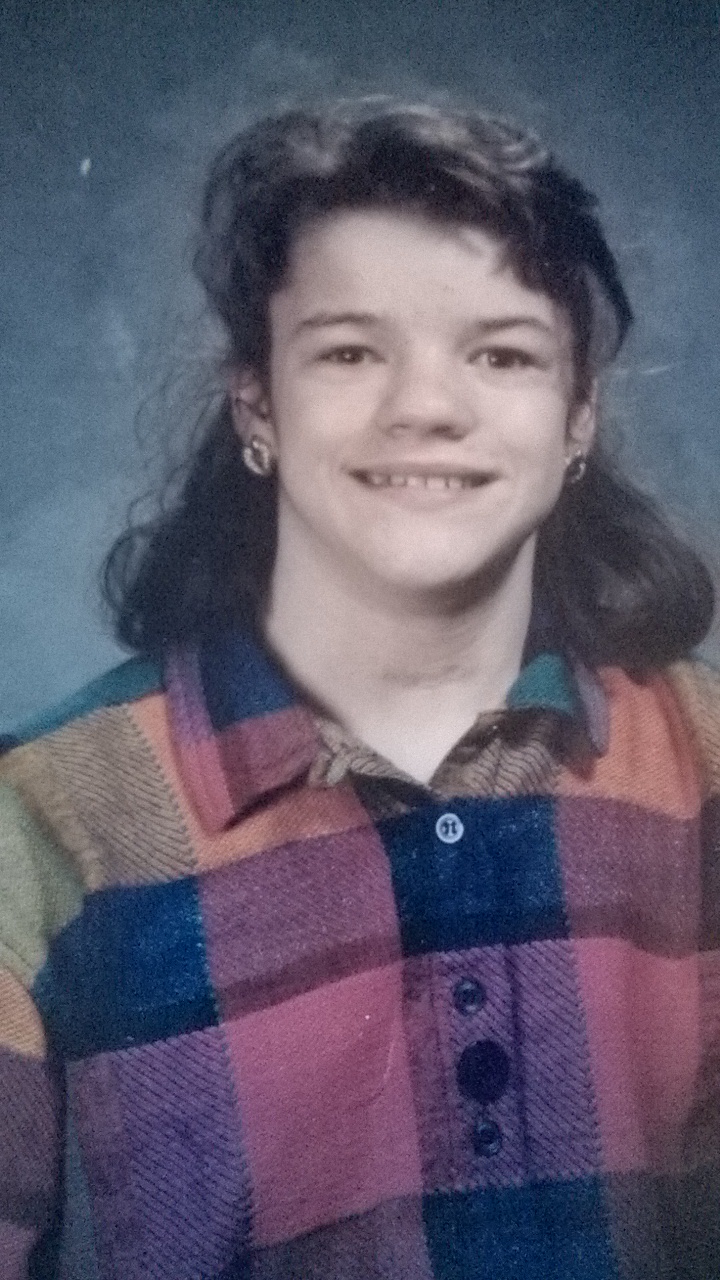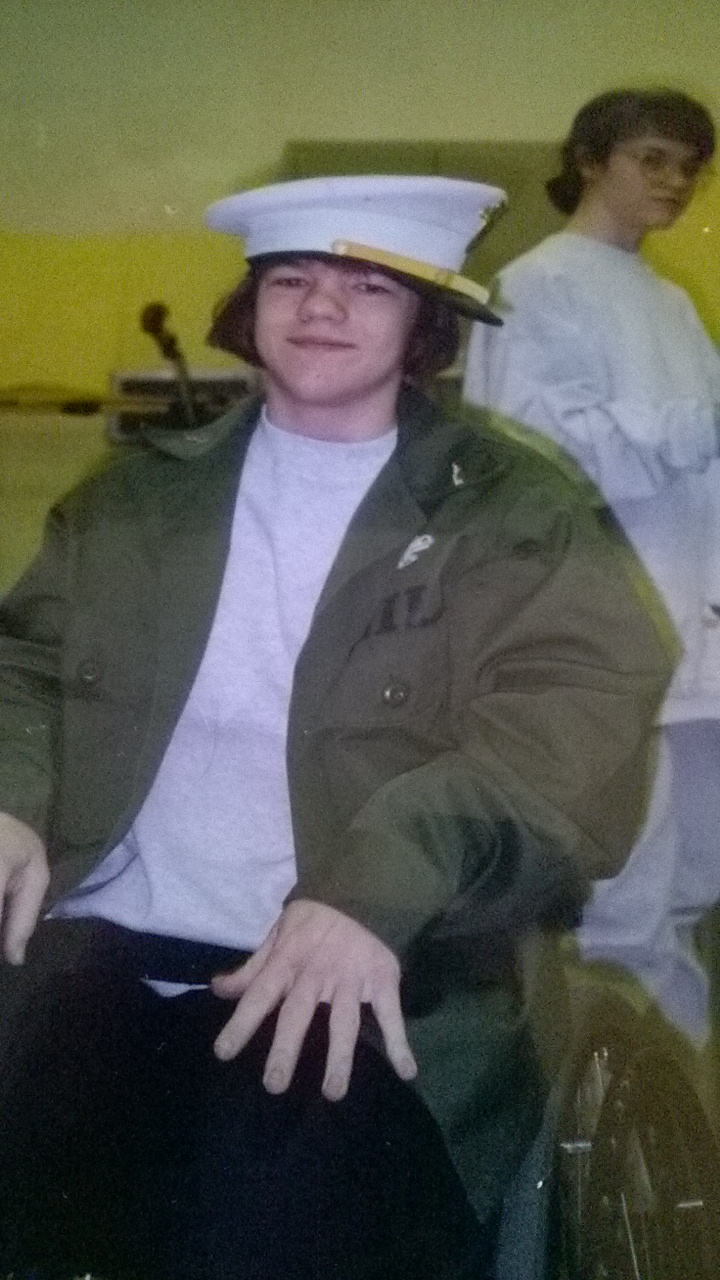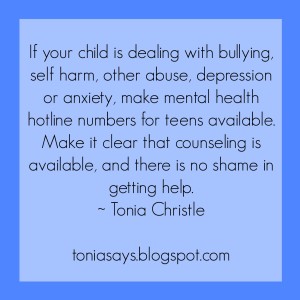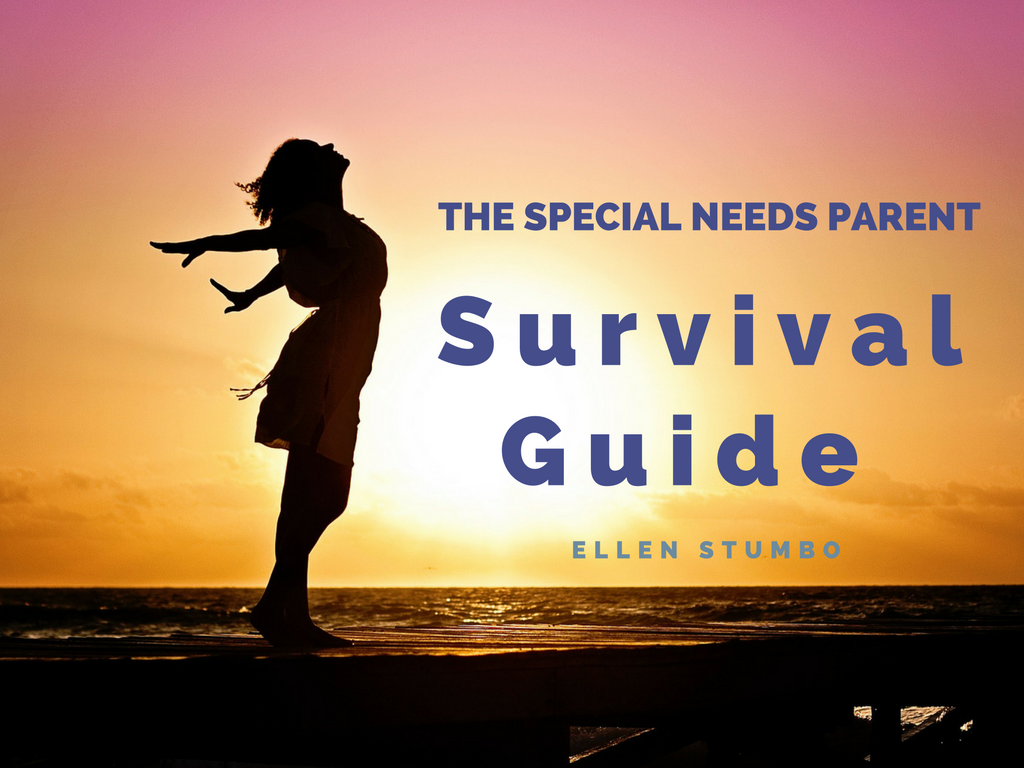Editor’s note: This is a guest post by Tonia Christle from Tonia Says for a blog series titled “Growing Up With a Disability.”
Middle school is difficult for everyone, but it can be especially trying when you’re growing up with a disability. I encountered several problem areas in my middle school years, all of which had more to do with being disabled than they did with it being a hard age. I covered the Early Years and the Elementary Years in the previous posts, but perhaps your child is beyond those stages and has entered into the tumultuous and hormone-filled middle school years. If so, this post is for you! Get ready to read about some aspects of middle school which, I think, are universally difficult for kids with disabilities, and I have some insight into what parents can do to help.

Myself (left) and my sister (right) on our eleventh birthday.
BULLYING:
I’d just turned eleven a couple of months before starting sixth grade. Nothing prepared me for the shift from the safe, cloistered environment of my fifth grade elementary school to this new, bustling place filled with older kids.
I also had no way of knowing my homeroom (where I would spend three class periods of seven) was taught by a strict, older teacher, who had cultivated the art of suddenly raising her voice sharply to say either, “No!” or “Now!” to keep unruly, disrespectful middle schoolers in line. This triggered my startle reflex and fried my nerves. It also made my classmates laugh at my expense. I laughed along, because it was either that, or feel more awful than I already did.
Having lunch in the cafeteria was also a more chaotic experience. I always sat at the very end of the lunch room table closest to the doors, so I could get in and out more quickly. One day, I was waiting for the line of kids to exit before I got up to do so myself, when an older boy slowed, and very intentionally spit a mouthful of food at me. I was too shocked to do anything other than brush myself off. It was so degrading I convinced myself it must have been an accident.

My seventh grade school picture shows me with shoulder length hair in a messy ponytail, and wearing no makeup.
ACCESSIBILITY
Right up to the end of seventh grade, I had been falling quite a bit. After sixth grade, accommodations were made for me to leave class early enough to avoid crowded halls, but that didn’t save me from getting knocked off balance by a smaller tote bag I carried or slipping on my own jacket while carrying it. And when the floors were freshly cleaned…forget it! The slippery surface was almost impossible to walk on. Add to this the fact that I was carrying my backpack from class to class all day, laden with all the textbooks, folders and notebooks I needed for seven classes and I was constantly off balance anyway. I’ll never forget when one of my teachers stopped me in the hall concerned about bruising he could see on my shoulders. I shrugged off his concern, because the bruises matched up perfectly with where the straps of my backpack dug in.
By eighth grade, the decision had been made for me to begin using my wheelchair full-time at school. It wasn’t one I liked. I felt that as long as I was physically able to walk from class to class, taking my wheelchair was unnecessary. I felt it would set me apart even more than I already was. But I’m glad my mom pushed for it, because it did make getting around in school easier and safer for me.
The chair didn’t solve all my accessibility issues, though. In my last year of middle school I had one of my classes in an outdoor portable classroom. In winter. As it wasn’t the end of the day, and the two minute passing times were hardly adequate to get anywhere, I rushed to join my classmates. By the time I got to the ramp leading up to the door, everyone was in class, and no one else was around. A layer of snow covered the ramp, deep enough that I could not push my way through. I tried for what felt like forever, before I gave up. With freezing hands, I made my way back into school and asked a former teacher with a free hour if I could warm my hands on her radiator for the remainder of class time. She agreed, and I was never more grateful for the warmth.

Winter of my eighth grade year, pictured in my wheelchair
SELF HARM:
Eighth grade also brought with it a return to self harm, though, honestly, I never thought deeply about actions I had taken to hurt myself. Two years previously, when I was eleven, was the first time. Now that I was older, I still didn’t understand it and I wasn’t overly concerned by it. But it did intensify.
It took many years for me to learn that people who self harm often have a history of having multiple surgeries as children. I had at least eight major surgeries between the ages of three days old and eleven years old. Instead of having massive amounts of pain inflicted on me via surgeries, I took the control back in a warped way, wanting to be in charge of when, and how badly I hurt. Also, especially in the early days, it was about how long I could stand certain physical pain.
HOW YOU CAN HELP:
If your child is dealing with any of the above issues, they probably are also having a more difficult time focusing on what they need to learn in school. Here are some simple ways you can help make this tricky time more bearable for your middle schooler with a disability:
 Mental Health Numbers, Websites and Counseling Available:
Mental Health Numbers, Websites and Counseling Available:
If your child is dealing with bullying, self harm, other abuse, depression or anxiety, make mental health hotline numbers for teens available. Make it clear that counseling is available, and there is no shame in getting help.
Shared Notebook or No Holds Barred Texting:
For some kids, sitting down and talking face to face with Mom or Dad can feel awkward or uncomfortable. Something as simple as a shared notebook, or knowing they can text you anytime, about anything, could make all the difference for your child. Especially if we are being bullied at school. It can be hard to look at our parents in the eye and tell them about it. Writing or texting allows us a buffer to be able to say the hard things that we might not otherwise be able to say. Be sure your child knows this notebook or text thread is a safe space where they can confide in you without worrying about siblings finding out, or being made fun of by anyone else in the family. Be sure they know they won’t be judged by you for what they share.
In School, Your Child’s Mobility Aid Should Be Whatever is Safest and Affords Them the Most Freedom:
There are plenty of opportunities to make sure your child stays active and maintains strength and flexibility. At school, our primary focus should be on learning. That is a struggle if we are constantly exhausted from walking everywhere or constantly scared of tripping and falling. If your child uses two or three mobility aids on a regular basis, always choose the one that affords them the most safety and freedom for at-school use.
If Your Child Is a Wheelchair User, Make Sure They Have a Good Pair of Gloves:
You wouldn’t send your able bodied kid to school without shoes, don’t send your kid who’s using a wheelchair to school without a good pair of gloves. These help create a good grip while pushing, and also protect from extreme hot or cold. In the warmer months, gloves like these work, but in the winter (especially if you live where it snows) make sure your kid has access to really good winter gloves. Lots of times, the warmer-weather gloves aren’t water proof, and they are going to want their fingers covered. Winter gloves need to be water proof, and the less bulky, the better.
There is no one-size-fits all solution for a disabled child in middle school, but it’s my hope that something you’ve read makes the road as a middle schooler a bit easier for your child to travel.
“Disability doesn’t make you exceptional, but questioning what you think you know about it does.” – Stella Young
***
 Tonia is a 30-something woman passionate about bridging the gap between disabled adults and parents of disabled children. She is also passionate about seeing a respectful representation of disability in the media. She blogs at Tonia Says, and you can best reach her at Tonia Says on Facebook.
Tonia is a 30-something woman passionate about bridging the gap between disabled adults and parents of disabled children. She is also passionate about seeing a respectful representation of disability in the media. She blogs at Tonia Says, and you can best reach her at Tonia Says on Facebook.
Special Needs Parents, Are You Surviving?
I created a guide with 13 practical ways to help you find peace in the midst of chaos, opt in to make sure you get a copy of this freebie!



Hi again!! 🙂
I am really enjoying this series….all of your posts speak to me, Tonia! Middle school was a particularly difficult time for me as well. The startle reflex thing – ohmygoodness YES! I don’t think most people realize that easy startling is part of CP, but it’s so frustrating for me when people intentionally make me jump and then laugh.
Lunchtime, classroom switching, and crowded hallways were all difficult for me as well. Heavy backpacks, lockers, navigating the halls and falling and leaving class early…like you said, it’s a tough age anyway and we all want to fit in, but there are so many “extras” that come with having CP that make these years even more challenging. For the first few weeks of sixth grade, I had an aide to “help” me in navigate the hallways, but she was more of a hindrance, especially socially, because it’s really hard to have a conversation with friends when you have a shadow listening in all day!
The part about the snow-covered ramp made me ache for you, but I’m so glad that there were still kind people in your life, like that former teacher, who might have made such a challenge more tolerable.
Also – thank you for sharing with us about your self-harm. I’m glad that you’re able to look back on those experiences now with such insight, and I think feeling “out of control” is something that so many of us can relate to during those middle school years (and like you said, it’s complicated further by having a disability/medical procedures).
My middle school years were complex. I was absolutely miserable in sixth grade, enjoyed seventh grade overall (because I found a core group of friends who accepted me and had kind teachers – sometimes that makes all the difference in the world!), and was homeschooled for most of eighth grade due to an accident that left me homebound.
I really appreciate you being so open about this, and looking forward to reading more!!! Thank you, Ellen and Tonia!
K, What jumped out at me the most from your comment was what you said about having an aide for a while in 6th grade. So did I. It was AWFUL. She would report back to my mom if I did ANYTHING she didn’t like, so it felt like I was being spied on and I didn’t even know it. So unnerving.
I’m so glad to know you are getting something out of all of these posts – even the ones that are a bit hodge-podgey like this one. Thanks for your feedback. I always love hearing from you!
Tonia, I appreciate you sharing your experiences. I wanted to let you know that I am so grateful to share your perspective and wisdom with my students who are training to become Ortho-Prosthetists in CA. Its a class focused on how to tune into the way disability impact people, families and couples differently cradle to grave and they really highlight each week how your practical tips have them thinking outside the box more than ever. Thank you! Please keep on sharing!